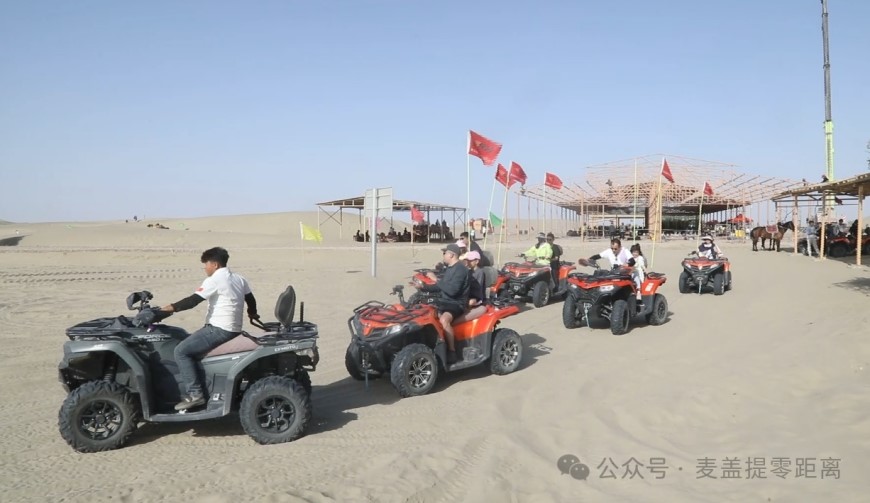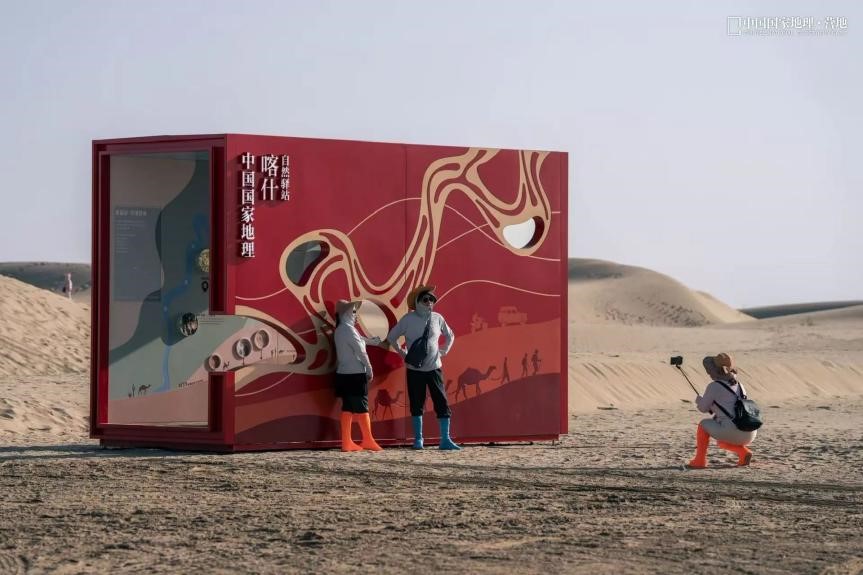"As a child, my dream was to escape Makit and distance myself from the Taklimakan Desert," recalled Reyhan Ehmet.
Born in 2001 in Makit county, Kashgar prefecture in northwest China's Xinjiang Uygur autonomous region, Reyhan remembers a childhood dominated by sandy landscapes. "Spring rarely brought greenery—instead, everything indoors and outdoors was shrouded in a yellow haze, with the acrid taste of sand lingering in the air," she added.

Tourists drive off-road vehicles in Makit. (Photo from the official account of the media center of Makit on WeChat)
Makit county, surrounded by the Taklimakan Desert on three sides, spans an area where 90% of its land is desert.
After graduating from university, Reyhan worked in Ningbo, east China's Zhejiang province. In February 2024, she returned to her hometown and was stunned by its transformation, prompting her to settle there permanently.
"Coming back, I now realize that we can manage, develop, and make good use of the Taklimakan Desert," she said.
Along the road from the county seat into the desert, a vast greenbelt of thriving trees extends for dozens of kilometers. This constitutes part of a 3,046-kilometer sand-blocking barrier encircling the Taklimakan, which Makit county has cultivated as its primary ecological defense system.
Since 2012, over 3 million residents have participated in Makit's desertification control initiatives, resulting in the creation of 1.176 million mu (approximately 78,400 hectares) of desert reclamation projects, including 460,000 mu of shelterbelt forests. To date, more than 260 million trees have been planted, including diversiform-leaved poplars, Xanthoceras sorbifolium, Euphrates poplars, Russian olives, tamarisks, and saxauls.

A dance performance is staged in a desert tourism site in Makit. (Photo by Liu Le)
"The Taklimakan Desert I see today is unrecognizable from the desert of my childhood," Reyhan said. The shift extends beyond environmental recovery to a broader cultural shift in how locals perceive development, prioritizing sustainability over exploitation.
"Many tourists from outside want to experience the desert up close," said Wang Jiangpeng, deputy director of the Makit county bureau of culture, sports, radio, television and tourism. While some visitors did come in the past, inadequate tourism facilities meant most only snapped photos at the desert's edge before leaving. In recent years, however, the county has revitalized its infrastructure and visitor services thanks to strong support from local governments, enterprises, and community stakeholders. This has boosted both its reputation and capacity to accommodate growing numbers of tourists.
"Last year alone, we received 400,000 tourists, and we anticipate surpassing 500,000 this year. Desert tourism is becoming a key driver of the county's economic growth," said Wang.
Encouraged by the boom in desert tourism, Reyhan decided to stay in Makit and joined a tourism development company. She now leads tourists on in-depth desert excursions deep into the Taklimakan.

Tourists pose for a picture in front of a desert-themed showroom in a tourism site in Makit. (Photo from Chinese National Geography)
Though she grew up on the desert's fringes, Reyhan never imagined it could evolve into such a lively destination.
During peak season, most tourists arrive around sunset. After trying out desert off-road driving and other activities, they return to the campsite to enjoy local song and dance performances and experience traditional flatbread-making. By night, they gaze at the desert's star-strewn sky, and at dawn, they climb towering dunes to witness the sunrise.
Even in the off-season, the camp is far from quiet. Tender green branches sprout from desert poplars, and Reyhan has "hosted" visits from curious jerboas and fluffy little foxes. One time, a colleague excitedly told her that a rare yellow sheep had appeared near the campsite.
The desert tourism area sits next to a populus euphratica forest park and the Tangwang Lake National Wetland Park in Makit.
"Tourism development must not compromise the desert's ecosystem, so we incorporated protective measures from the very beginning," Reyhan said. Alongside expending water, electricity, and internet infrastructure to the campsite, they also built nearby facilities for wastewater treatment and waste management facilities to ensure no waste is left in the desert.
Grabbing a handful of fine sand, she let it fall onto her pants, then gave them a shake - the sand was so clean that her pants were spotless again. "The sand here is very clean, and we must take good care of it," Reyhan said.
"For Makit, desert tourism brings jobs and increases incomes. By balancing desert conservation, ecological restoration, and sustainable development, we've forged a model that harmonizes environmental protection with economic progress," said Wang Faqiang, deputy Party chief of Makit county.
"Desert tourism is a rich resource. As China's largest desert, the Taklimakan is expected to draw more and more visitors through the integrated model of 'desert control + industry + employment + tourism,'" Wang Faqiang added.









